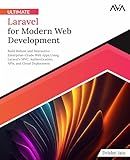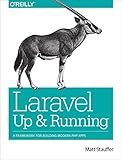Best Laravel Tutorial Resources to Buy in December 2025

Laravel: Up & Running: A Framework for Building Modern PHP Apps



Laravel 12 for Beginners & Beyond: A Complete Guide to Building Modern PHP Web Applications with Clean Architecture, Hands-On Projects, and Best Practices



Laravel: Up & Running: A Framework for Building Modern PHP Apps



Architecture of complex web applications. Second Edition.: With examples in Laravel(PHP)



Mastering Laravel 12 : Advanced Techniques for Modern PHP Development



Ultimate Laravel for Modern Web Development: Build Robust and Interactive Enterprise-Grade Web Apps using Laravel's MVC, Authentication, APIs, and ... (Advanced Web Frameworks — Multi-Tech Path)



Practical Laravel: Develop clean MVC web applications



Laravel: Up and Running: A Framework for Building Modern PHP Apps


To send a PUT request in Laravel, you can use the put method provided by Laravel's HTTP client (typically accessed through the Http facade).
You will need to specify the URL you want to send the PUT request to, as well as any data you want to include in the request body. You can pass the data as an array to the put method.
Here is an example of how you can send a PUT request in Laravel:
$response = Http::put('https://example.com/api/resource/123', [ 'key1' => 'value1', 'key2' => 'value2' ]);
In this example, we are sending a PUT request to the URL https://example.com/api/resource/123 with the data key1 set to value1 and key2 set to value2.
You can also include headers in your PUT request by passing them as the second argument to the put method. Additionally, you can chain other methods such as withHeaders or withoutRedirecting to customize your request further.
After sending the PUT request, you can retrieve the response using the json method to convert it to a JSON object, or access the response data using other methods such as body, status, and ok to check the status of the request.
What is the syntax for making a PUT request in Laravel using Guzzle?
To make a PUT request using Guzzle in Laravel, you can use the following syntax:
use GuzzleHttp\Client;
$client = new Client();
$response = $client->request('PUT', 'http://example.com/api/resource', [ 'json' => [ 'key' => 'value' ] ]);
$body = $response->getBody(); $data = json_decode($body, true);
dd($data);
In this example, we are sending a PUT request to http://example.com/api/resource with a JSON payload containing a key-value pair. You can modify the 'json' parameter to include any data you want to send in the request body.
How to pass data with a PUT request in Laravel?
In Laravel, you can pass data with a PUT request using the request() method. Here's an example of how you can pass data with a PUT request in Laravel:
- In your routes file, define a route for handling the PUT request:
Route::put('/update/{id}', 'YourController@update');
- In your controller, define the update method:
public function update(Request $request, $id) { $data = $request->all();
// Update the data in the database
// Example: User::where('id', $id)->update($data);
return response()->json(\['message' => 'Data updated successfully'\]);
}
- Make a PUT request to the /update/{id} endpoint with your data using a tool like Postman or a JavaScript fetch call:
{ "name": "John Doe", "email": "johndoe@example.com" }
By using the request() method in your controller, you can access the data sent with the PUT request and update the data in the database accordingly.
How to create custom middleware for processing PUT requests in Laravel?
To create custom middleware for processing PUT requests in Laravel, follow these steps:
- Create a new middleware class by running the following command:
php artisan make:middleware ProcessPutRequests
This will create a new middleware class named ProcessPutRequests in the app/Http/Middleware directory.
- Implement the middleware logic in the handle method of the newly created ProcessPutRequests class. For example, you can check if the request method is PUT and process the request accordingly. Here is an example implementation:
